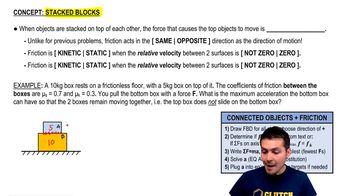Here are the essential concepts you must grasp in order to answer the question correctly.
Newton's Second Law of Motion
Newton's Second Law states that the acceleration of an object is directly proportional to the net force acting on it and inversely proportional to its mass. This relationship is expressed by the formula F = ma, where F is the net force, m is the mass, and a is the acceleration. In this scenario, understanding how the applied force affects the acceleration of the blocks is crucial for determining the forces between them.
Recommended video:
Intro to Forces & Newton's Second Law
Force Interaction Between Blocks
When multiple objects are in contact and a force is applied, they exert forces on each other according to Newton's Third Law, which states that for every action, there is an equal and opposite reaction. In this case, the 2 kg block will exert a force on the 1 kg block as a result of the acceleration caused by the applied force. Analyzing these interactions helps in calculating the force exerted by one block on another.
Recommended video:
System of Masses
In this problem, the three blocks can be considered as a single system when a force is applied. The total mass of the system (1 kg + 2 kg + 3 kg = 6 kg) will determine the overall acceleration when the 12 N force is applied. Understanding the system as a whole allows us to find the acceleration and subsequently the forces acting on each individual block, which is essential for solving the question.
Recommended video:
Adding Mass to a Moving System




